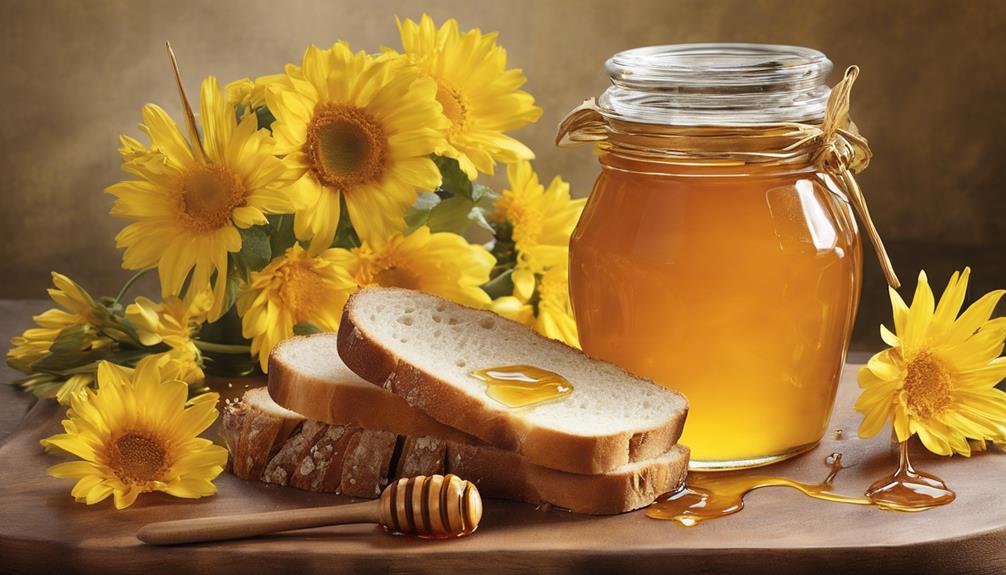Honey fermentation lets you craft mead and various fermented goodies with just a few ingredients. Start by mixing high-quality honey with low mineral content water and adding a specific yeast strain. Keep the fermentation cool for about 4 to 5 weeks, stirring regularly for even fermentation. Once done, aging your mead at controlled temperatures enhances its flavors, creating a rich taste profile. Historically, mead has celebrated life's special moments and has a fascinating cultural backdrop. If you're curious about serving suggestions or culinary uses, there's plenty more to explore about this delightful craft!
Key Takeaways
- High-quality honey mixed with clean, low-mineral water is essential for successful fermentation of mead and other honey-based products.
- The fermentation process typically lasts 4 to 5 weeks at cooler temperatures around 9°C, activating wild yeasts and bacteria.
- Aging mead at a controlled temperature of around 10°C enhances complex flavor development, making it more enjoyable.
- Fermented honey products can boost immunity and possess antibacterial properties, with a low pH that minimizes spoilage risks.
- Mead has a rich historical significance, being one of the oldest beverages, celebrated in various cultures for its flavors and role in rituals.
Choosing the Right Ingredients
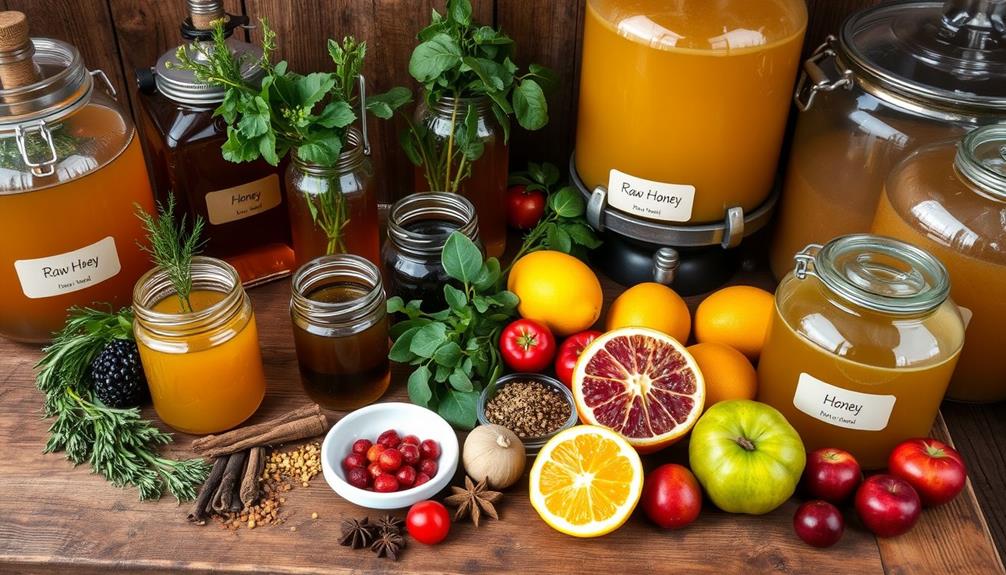
When you're diving into honey fermentation, choosing the right ingredients is vital for crafting a delicious mead. Start with high-quality honey, as its flavor can vary by season. If you want unique tastes, consider single-flower honey; however, blends can save you money while still delivering great results.
Additionally, incorporating essential oils for toothache relief can enhance the overall sensory experience of your mead, providing soothing and aromatic notes that complement the drink.
Next, pay attention to the water you use. Opt for clean drinking water with low mineral content, since the quality of your water greatly affects the final product's taste.
Don't overlook the yeast! Specific strains are important for successful fermentation, and they usually cost around 4 euros for 20 grams, enough for about 100 liters of mead. Make sure to include necessary nutrients for the yeast to flourish during fermentation, as this can enhance the overall flavor profile of your mead.
Lastly, if you're feeling adventurous, consider experimenting with alternative ingredients. A 2% salt brine can serve as a vegan option, adding a unique twist to your mead and influencing the fermentation behavior.
Choose wisely, and you'll lay a solid foundation for a delightful mead-making experience!
Starting the Fermentation Process
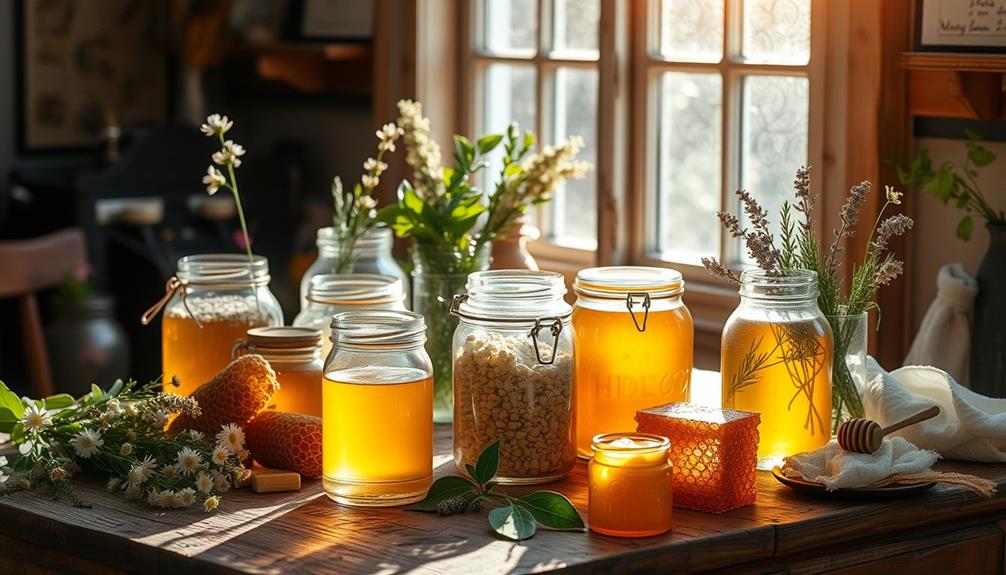
To kick off the fermentation process, you'll mix your chosen high-quality honey with clean water and the specific yeast strain you've selected. This step is fundamental, as it sets the foundation for the mead you'll create. Aim for a fermentation temperature of around 9°C to enhance flavor development. Proper attention to the fermentation process can also help prevent issues such as ear pressure during colds, ensuring a smoother experience.
Here are some key points to remember:
- Yeast activation thrives at higher temperatures (about 25°C).
- The fermentation process typically lasts 4-5 weeks, resulting in mead with over 10% alcohol content.
- Regular stirring and aeration help prevent stagnant fermentation.
During this period, the yeast will work its magic, producing carbon dioxide and ethanol while wild yeasts from the honey contribute to the overall fermentation.
It's important to keep an eye on the mixture, monitoring for sediment and clarity. A clean final product is critical before you move on to aging.
Aging and Maturation Techniques

When aging mead, temperature plays an essential role in shaping its flavor profile. You'll find that maintaining a controlled environment around 10°C allows the mead to mature gracefully over time.
Proper temperature regulation is important for achieving ideal flavor, similar to how advanced technology in enhanced temperature regulation is crucial for heat pumps.
The duration of this maturation process is equally important, as longer aging can lead to more complex and intense flavors that enhance the overall character of your mead.
Aging Temperature Effects
The ideal aging temperature for mead plays an essential role in developing its flavor profile. Maintaining a controlled temperature of around 10°C notably enhances the mead's flavors over time. This careful management allows the natural essence of the honey and other ingredients to evolve, creating a more sophisticated taste with each passing month.
- Proper temperature promotes fermentation stability.
- Cooler aging helps in developing complex flavor notes.
- It minimizes the risk of spoilage and off-flavors.
During the aging process, you won't be adding any extra ingredients, preserving the mead's purity and allowing it to mature naturally.
You'll notice that sediment formation is common, so be sure to pour carefully when serving to avoid disturbing it. This sediment is a byproduct of the aging process, indicating that your mead is evolving.
In the end, experienced tasters often evaluate the final product before bottling. Their discerning palates confirm that what you're about to share with others reflects the quality you've worked hard to achieve.
Maturation Duration Importance
Maturation duration plays a critical role in shaping the final character of your mead. As you allow your mead to age at a consistent temperature of 10°C over several years, you'll notice the development of complex flavors and aromas that can elevate your creation from good to exceptional.
Longer maturation periods often lead to a smoother and more refined product, enhancing the overall tasting experience.
Throughout the aging process, be aware that sediment may develop in your bottles. This is completely normal, so when pouring, do it carefully to avoid disturbing the sediment, as it can affect the taste.
Before bottling, experienced tasters evaluate the final flavor profile to ascertain the mead meets desired quality standards.
Historical Context of Mead Production

Mead's roots stretch back to ancient civilizations, where it was more than just a drink; it was woven into the fabric of rituals and social gatherings.
You'll find references to mead in the writings of the Greeks and Romans, often tied to their gods and significant cultural events.
As you explore its historical journey, you'll see how this beverage shaped traditions from the feasting halls of the Anglo-Saxons to the quiet brewing practices of medieval monasteries.
Ancient Mead Traditions
Evidence suggests that mead production has roots stretching back over 9,000 years, making it one of humanity's oldest fermented beverages. You can find evidence of its consumption in archaeological sites, like those in China dating back to 7000 BC. Ancient cultures embraced mead for its unique flavors and intoxicating properties, weaving it into their societal fabric.
- In ancient Greece, mead was a drink of the gods, often featured in religious ceremonies.
- Vikings brewed mead as a staple during feasts, with Norse mythology celebrating its importance.
- During medieval times, mead enjoyed popularity among nobility and was even used as currency.
These traditions highlight how mead transcended mere beverage status, becoming a significant part of ancient life. Its flavors and rituals fostered community and connection, whether in sacred rites or festive gatherings.
While mead's prominence waned in the 19th century due to the rise of beer and wine, the craft beverage movement has sparked a revival, allowing you to appreciate this ancient drink anew. As you explore mead's rich history, you'll discover how it continues to resonate through time.
Cultural Significance of Mead
Throughout history, mead has held a special place in various cultures, often celebrated as the "nectar of the gods." From ancient rituals to modern festivities, this beverage has marked significant life events such as weddings and harvest celebrations. Evidence of mead production dates back over 4,000 years, with ancient Sumerians and Egyptians crafting this golden elixir.
During the Viking Age, mead flourished in Scandinavia, where it was a staple at feasts and linked to Norse mythology, celebrated as a drink of the gods. Though its popularity waned with the rise of beer and wine, mead has seen a resurgence in recent decades as craft meaderies pop up around the globe.
Culturally, mead has woven itself into literature and folklore, appearing in ancient texts and modern fantasy novels. It symbolizes hospitality, friendship, and the joy of life, making it a perfect companion for gatherings and celebrations.
Whether you're raising a toast at a wedding or enjoying a quiet evening, mead's rich history and cultural significance continue to resonate, reminding you of its timeless appeal and the connections it fosters.
Enjoying Mead: Serving Suggestions

When it comes to enjoying mead, the way you serve it can greatly enhance your experience. Whether you prefer it warm, chilled, or frozen, mead offers versatility that caters to different moods and occasions. Here are some serving ideas to elevate your mead enjoyment:
- Serve warm at 50°C for a cozy winter treat.
- Enjoy chilled or frozen in summer for a revitalizing twist.
- Pair with complementary foods like cheese or spicy-sweet dishes.
For a comforting experience, consider serving your mead at room temperature. This allows the rich flavors to shine through.
If you're in a chilly setting, heating the mead to around 50°C in cups won't only warm you up but also enhance its aromatic qualities.
On the other hand, during hot summer days, chilling mead or even freezing it can create a delightful drink, as the ice forms while the alcohol remains liquid.
Fermentation Process With Honey

Serving mead is just the beginning of the journey; understanding the fermentation process with honey reveals how this delightful beverage comes to life.
It all starts when you mix honey with water, activating wild yeasts and bacteria. This combination usually requires about 20% moisture content for ideal fermentation, allowing these microorganisms to convert sugars into alcohol.
During fermentation, which typically takes place in cooler temperatures around 9°C, you'll notice the production of carbon dioxide and ethanol, while lactic acid remains minimal. The alcohol content can vary from 0.5% to 7%, depending on the sugar levels in the honey and any other ingredients you might add.
Yeast activation kicks off at higher temperatures, around 25°C, and the entire process lasts about 4 to 5 weeks.
As fermentation progresses, you'll experience bubbles forming, a distinct alcoholic scent, and even a yeast-like aroma. The wild yeasts from the nectar play a vital role in this transformation.
Once fermentation is complete, it's important to clarify the mixture by removing sediment, setting the stage for aging and ensuring a purer final product ready for your enjoyment.
Culinary Uses for Fermented Products
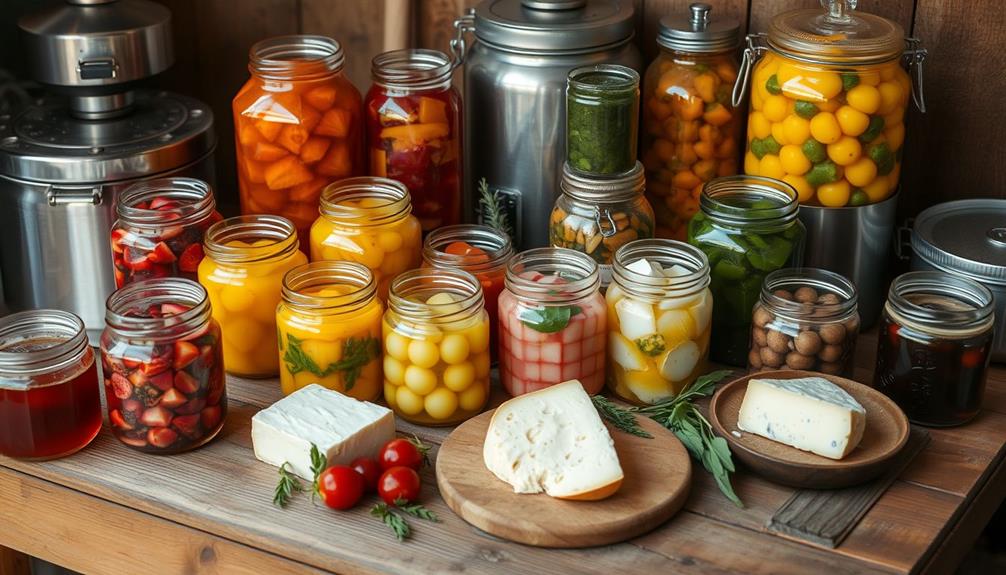
Fermented products often find their way into kitchens, adding depth and complexity to a variety of dishes. Their unique flavors can elevate your culinary creations in exciting ways.
Here are some ways you can incorporate these delightful items into your meals:
- Fermented garlic in honey: Enjoy it like candy or use it as a flavorful spread, enhancing your dishes with its sweet, sharp, and caramel-like taste.
- Fermented tomatoes: Serve them plain or atop bread, pairing perfectly with cheese. You can also puree them for spreads, catering to a wide range of palates.
- Fermented honey products: These can be delightful toppings, especially when combined with wild cranberries. They're not just tasty; they also make great gifts due to their attractive presentation.
You'll find fermented honey's versatility shines in spicy-sweet curries or as a seasoning in meatballs, contributing unique flavor profiles to your favorite recipes.
By experimenting with these fermented delights, you'll discover new layers of taste that can transform even the simplest dishes into something extraordinary.
Embrace the culinary magic of fermentation and let your creativity flow!
Health Benefits and Safety Tips
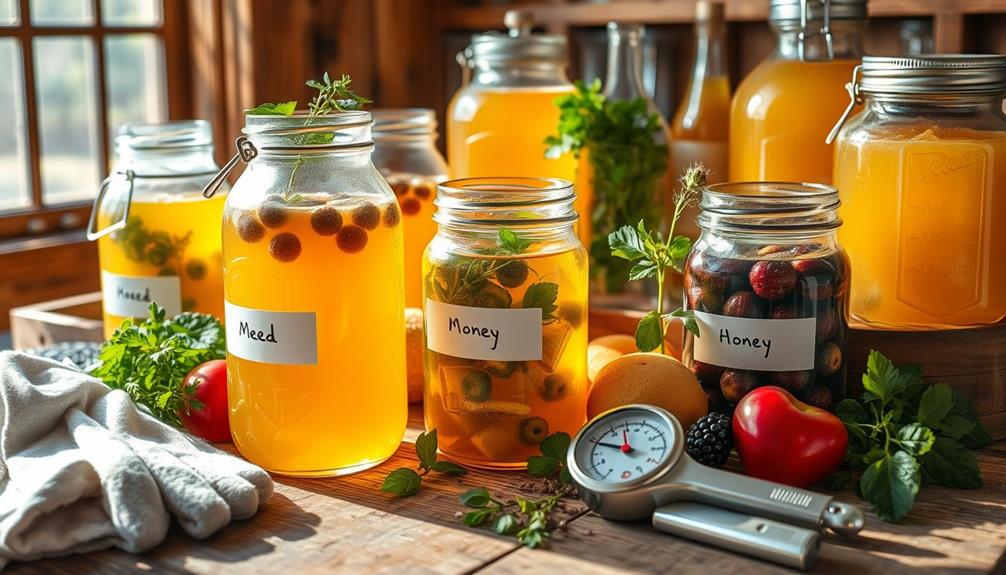
Incorporating fermented products like honey and garlic into your diet not only enhances flavor but also brings a range of health benefits. Both garlic and honey have natural antibacterial and antiviral properties, boosting your immune system and promoting overall health. While claims about their effects on cholesterol and blood pressure aren't scientifically backed, they still contribute positively to your well-being.
When fermenting honey, the pH typically falls below 4.6, greatly reducing the risk of botulism, making it a safe option for fermentation. However, regular monitoring for signs of spoilage, like unusual odors or mold, is essential. Here's a quick reference table for health benefits and safety tips:
| Health Benefits | Safety Tips |
|---|---|
| Boosts immune system | Monitor for spoilage signs |
| Antibacterial properties | Maintain low pH |
| Antiviral properties | Stir regularly for oxygen |
While honey ferments can contain between 0.5% to 7% alcohol, it's generally lower than mead. By stirring regularly during fermentation, you introduce oxygen, safeguarding against spoilage and promoting even fermentation. Enjoy the benefits while staying safe!
Frequently Asked Questions
How Is Mead Made From Honey?
To make mead from honey, you mix honey with water and yeast, then let it ferment at low temperatures. After a few weeks, you'll have a unique beverage ready for aging and flavor development.
Can Honey Be Fermented?
Yes, honey can be fermented! When its moisture content hits around 20%, natural yeasts and bacteria transform sugars into alcohol. This process can yield various products, including mead, offering unique flavors and aromas.
What Is Fermented Mead?
Imagine a golden elixir, where sweet nectar meets yeast's transformative dance. Fermented mead's your creation, born from honey and water, bubbling with flavors as alcohol weaves its magic, inviting you to savor each delightful sip.
What Is Produced as a Product of Fermentation?
During fermentation, you produce alcohol, carbon dioxide, and various flavors. The process transforms sugars into ethanol, resulting in beverages like beer or wine, while also creating unique taste profiles that enhance culinary applications.
Conclusion
In summary, diving into honey fermentation opens up a world of delicious possibilities. Whether you're crafting your own mead or experimenting with other fermented delights, the journey is as sweet as a bee's nectar! Remember to savor each step, from selecting the best ingredients to perfecting the aging process. So go ahead, release your inner alchemist and transform that honey into liquid gold. Cheers to your brewing adventure—may it be as legendary as the tales of ancient mead-makers!





